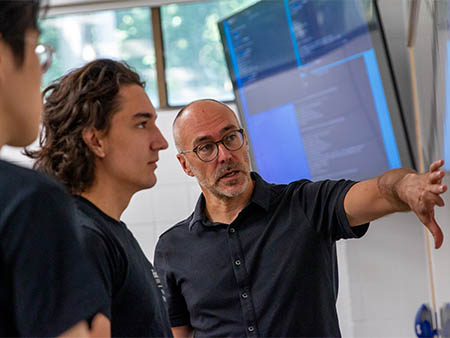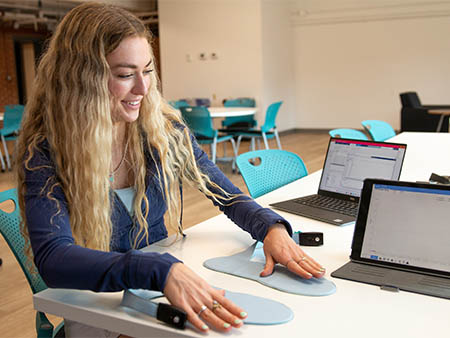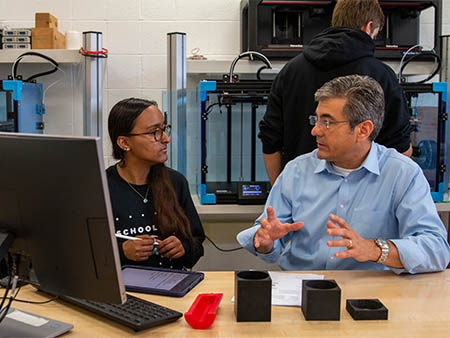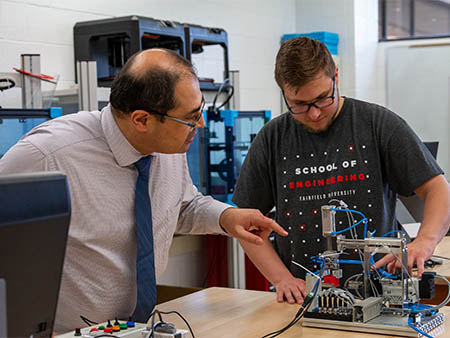On This Page
Undergraduate Research at the School of Engineering & Computing
In keeping with the mission of Fairfield University’s Jesuit values, specifically the concept of men and women for others, the School of Engineering & Computing inspires students to become leaders of integrity within the industry. Through their comprehensive curriculum, students are given opportunities to conduct innovative, in-depth research with faculty mentors. This hallmark of a solid educational experience offers students a chance to put their academic skills to the test, explore their passions, and make a difference.
Current & Past Research Projects
Micro Bioreactor for Tissue Scaffolds

The goal of this research project is to fabricate microwave foamed, three-dimensional (3D) tissue scaffolds leading to extracorporeal bio-artificial organ systems that will assist in organ transplantation. Associate Professor Mechanical Engineering Sriharsha Sundarram, PhD, and engineering students Nwachukwu Ibekwe, Stephanie Prado, Sean Feeney, Clarissa Rotonto project builds on the work currently being performed in the school’s research group on fabrication of 3D tissue scaffolds for biomedical applications.
Three-dimensional tissue scaffolds can be used to grow cells and replicate the functioning of the tissues in the human body. However, the major challenge in the fabrication of large-scale 3D tissue scaffolds is the need to have highly porous and interconnected scaffolds with desired mechanical properties to allow for cell growth and proliferation. In this study, a unique approach of combined additive manufacturing (3D printing) and microwave foaming is adopted to fabricate tissue scaffolds. These scaffolds with desired properties will be incorporated into bioreactor chambers integrated with sensors and fluidic networks resulting in extracorporeal bio-artificial organs. The key outcomes upon successful completion of this project include: (1) Fabrication of a scalable, inexpensive system for development of bio-artificial organs; and, (2) Opportunity for graduate and undergraduate students at Fairfield University to participate directly in state-of-the-art research.
DNA-Repair

Under the leadership of faculty mentor Isaac Macwan, PhD, biomedical engineering majors Jenna Madigan ’22 and Jack Devlin ’22 launched a research project that focuses on the impact of the human protein MutSbeta, which is essential in repairing incorrect sequences in DNA after replication. The overall role of MutSbeta is known but our goal is to examine the initial interactions when the DNA and protein first come in contact. By simulating the interactions as they would happen in our cells with molecular dynamics, we hope to learn about this system through analysis of interaction energies, changes in protein structure, and more. With this information, the students will draw conclusions about the implications of defective MutSbeta, which causes human Lynch Syndrome and colorectal cancer.
Identification of True and False Memory Using Brain Activity Patterns

Human memory is not infallible - people often provide false reports of events, either by providing incorrect details of an event or recounting an event that never occurred. And yet, they believe they are telling the truth when they give this quantifiably false information. This is because it is often the memory of the person that is incorrect. This phenomenon is known as False Memory.
An interdisciplinary collaboration between the Department of Psychology and the Department of Computer Science, Assistant Professor of Psycology Jessica Karanian, PhD, Assistant Professor of Computer Science and Engineering Danushka Bandara, PhD and students Tal Nizan and Thanh Le aim to identify whether a person is experiencing a true or false memory by exclusively using their brain activity patterns. This method can be applied to battle misinformation and to test if witness testimony is trustworthy.
Demonstrating innovative thinking, Dr. Karanian, Dr. Bandara, Nizan, and Le utilized event-related potentials (ERP), a technique known for its high temporal resolution, to see whether there was a difference in neural activity was visible between false and true memories. If a difference was found, an additional goal is to discern where and when false memories originate. After using this method, they were able to find a significant difference in activity in the occipital lobe during true and false memory.
Classification of Workload/Emotion While Wearing Virtual Reality Headsets
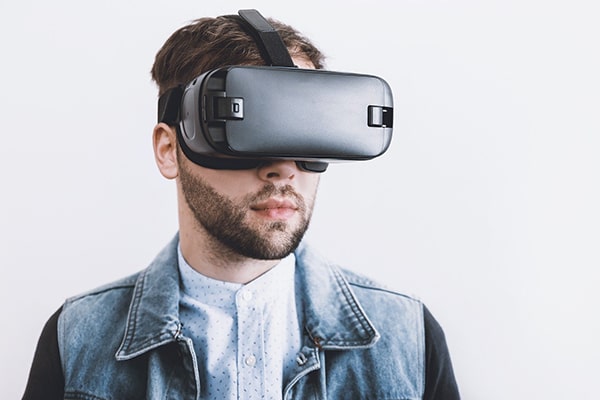
Virtual reality is an emerging modality for interacting with computers. Danushka Bandara, PhD's project aims to identify a computer user’s workload and emotion levels while immersed in Virtual Reality experiences. Such a system has great potential in training aircraft pilots, athletes, and other professions where virtual reality is used to train for hazardous or high-stakes situations. Ultimately, these devices could be in everyday use, sensing and adapting to humans when using computers.
Heart Failure

In their research project, Andrey Zaznaev and Ky Duyen Le ’21 worked alongside faculty mentor Isaac Macwan, PhD to study how molecules move and behave in biological system through molecular dynamics simulations. The specific focus is on understanding how graphene oxide, a nanoparticle, interacts with NDPK, a protein responsible for many processes in a human body, including the functioning of the heart. Heart failure results from the interactions of an inferior NDPK protein with another protein called G protein that inhibits the beating of the heart resulting in cardiac infarction. It is expected that the results of this work will show theoretical potential for utilizing graphene oxide material blocking such interactions to be a possible strategy against heart failure.
Classification of Feline Species Using Audio of their Calls

Usually, humans are easily able to distinguish different sounds from one another, but this becomes increasingly difficult when these sounds pertain to relatively similar sounds coming from sources such as a growl from two related cat species. In this collaborative study, Associate Professor of Biology Ashley Byun, PhD, Assistant Professor of Computer Science and Engineering Danushka Bandara, PhD and students Nicholas Furey, Karen Exantus, Tianyu Yang, Rohindraj Kandasamy, Saigreeshma Saladi aimed to identify feline species using only the audio signature of their calls.
The project combines signal processing and cutting-edge machine learning methods to achieve its goal. The team hopes to use the model generated by this work to recreate the calls of the ancestral feline species that are currently extinct.
Amyloid Beta and Alzheimer’s Disease
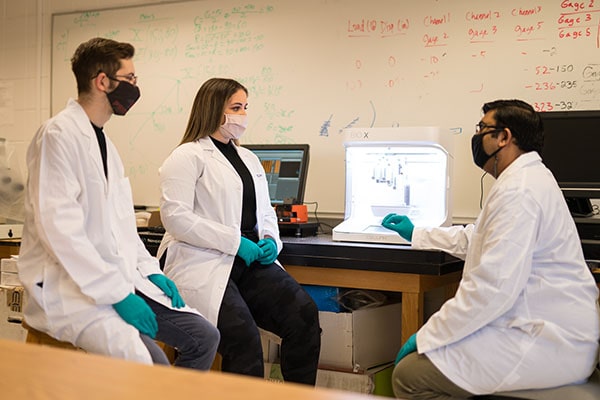
One of the root causes of Alzheimer’s disease is the aggregation of amyloid beta protein in the brain. In Isabella Wolson’s ’22 project, mentored by Isaac Macwan, PhD, the aggregation of several amyloid beta proteins are simulated alone and then in the presence of a nanomaterial, graphene oxide. The simulations are then examined to determine if nanomaterials should be pursued as a potential therapeutic agent in de-clumping the Alzheimer’s causing clusters.
Getting involved in faculty-mentored undergraduate research is a great way to supplement course work and gives students the chance to explore a topic at the cutting-edge of the biomedical engineering discipline. To learn more, meet with your academic advisor to discuss your research interest.
Undergraduate Summer Research Residency
As the School of Engineering & Computing is committed to maintaining a supportive and rigorous research environment for our students, and have several exciting workshops and seminars planned to enhance their experience and knowledge through their tenure in the program.
Fairfield University’s School of Engineering & Computing strives for engineering with a higher purpose, and, as reflected in the makeup of our studies, our rigorous research in emerging fields also considers society and economic, environmental, and social development of broader communities.
This summer, 27 Students were selected as a researcher in the program where they worked with faculty advisors in the School of Engineering & Computing. Their research topics ranged from Analyzing cyber-threats using data collected from honeypot to Measuring trust and performance in human AI interaction, and to, Printing scaffolds with cells using BioX 3D printer.

